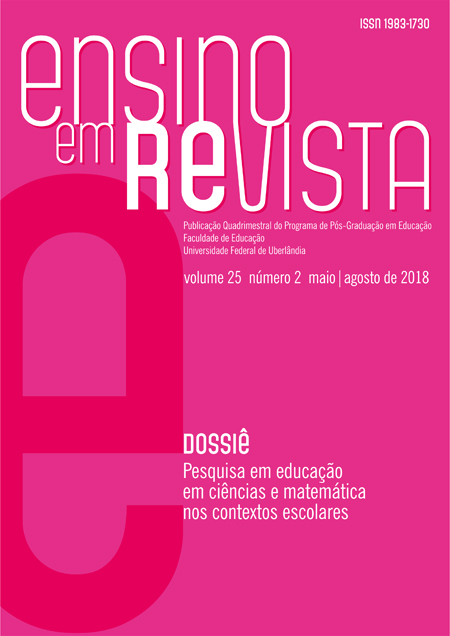The contribution of the signalers to scientific dissemination on Sign Language
Main Article Content
Abstract
This article aims to analyze the production of the signalers -Glossaries in Brazilian Sign Language (Língua Brasileira de Sinais –Libras) –regarding to the Science area, in which can be found on the digital sharing platform Youtube. We seek to present the importance of these resources for the expansion of the scientific dissemination in educational and social scope, as well as to understand how the education of deaf students occurs and also how the signalers contribute to make the area of science accessible to this public. The research has a bibliographic and documentary shape, as it makes references to authors who research on the education of the deaf and scientific dissemination, besides the analysis of videos with signalers in Libras (Brazilian Sign Language) available on the digital sharing platform Youtube. With this research we realized that there is no standardization in the signs because there is a tendency to be organized by institutions respecting the regional linguistic variation, making it difficult for a broader public to understand.
Downloads
Article Details
The published works are the property of their authors, who may make use of them for subsequent publications, always including the original edition (original title, Ensino em Re-Vista, volume, number, pages). All articles in this journal are the sole responsibility of their authors, and no legal responsibility for their content rests with the Journal or EDUFU.
References
BARDIN, L. Análise doconteúdo. Tradução Luís Antero Reto, Augusto Pinheiro.São Paulo: Edições 70, 2016.
BUENO, W. da C. Comunicação científica e divulgação científica: aproximações e rupturas conceituais. Revista Informação & Informação. Londrina, v. 15, Ed. esp., p. 1–12, 2010. Disponível em http://www.uel.br/revistas/uel/index.php/informacao/article/view/6585. Acesso em 25, jan. 2017.
FRANCO, M. L. P. B. Análise de Conteúdo. 3. ed. Brasília: Liber Livro Editora, 2008.
JUNIOR, G. C., Projeto Varlibras.Brasília: Distrito Federal, 2014. 264 f. (Tese de Doutorado), Universidade de Brasília, 2014. Disponível em: repositorio.unb.br/bitstream/10482/17728/1/2014_GlauciodeCastroJunior.pdf. Acesso em 27 fev. 2017.
OLIVEIRA, V. R., PALAORO, G. M., GONÇALVES, P. MALACARNE, V. A Divulgação Científica no Youtube: Acessibilidade ao Conhecimento Científico por meio da Língua Brasileira de Sinais –Libras. In: Simpósio Nacional de Educação. Anais do V Simpósio Nacional de Educação. Cascavel, Unioeste, 2016, p.1-14. Disponível em http://midas.unioeste.br/sgev/eventos/vsne/anais. Acesso 20, jan, 2017.
REALE, M. V., MARTYNIUK, V. L. Divulgação Científica no Youtube: a construção de sentido de pesquisadores nerds comunicando ciência. In: XXXIX Congresso Brasileiro de Ciências da Comunicação. São Paulo, 2016. Anais do XXXIX Congresso Brasileiro de Ciências da Comunicação. São Paulo, PUC, 2016, p. 1-15. Disponível em: http://portalintercom.org.br/anais/nacional2016/resumos/R11-0897-1.pdf. Acesso: 10, fev. 2017.
SANTOS, J. A. H. S. Vídeos Da Internet Que Contemplam Pessoas Surdas: Análise Do Potencial Para A Educação Não Formal Em Ciências E Biologia. São Paulo, 2014. 35 f. (Originalmente apresentado como Trabalho de Conclusão de Curso), Universidade Presbiteriana Mackenzie, São Paulo. Disponível em: http://www.mackenzie.br/fileadmin/PUBLIC/UP_MACKENZIE/servicos_educacionais/graduacao/Ciencias_Biologicas_SP/TCCs/2o_2015/Juliana_Ap_Henriques_dos_Santos.pdf. Acesso em 25 jan. 2017.
SCHNEIDER, C. K.; CAETANO, L.; RIBEIRO, L. O. M. Análise de Vídeos Educacionais no Youtube: Caracteres e Legibilidade. Revista Renome: Novas Tecnologias na Educação. V. 10 Nº 1, p. 1-11, julho, 2012. Disponível em: http://seer.ufrgs.br/index.php/renote/article/view/30816/19202. Acesso em 12 fev. 2017.

